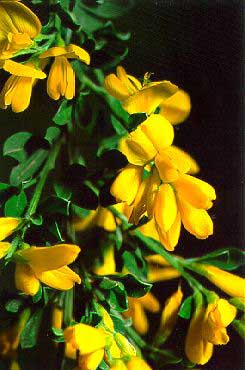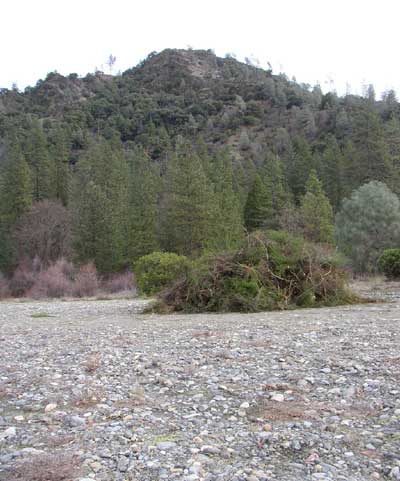Manually Controlling Brooms In & Around Junction City
In cooperation with
Bureau of Land Management (BLM), California Department of Transportation
(Caltrans),
& Trinity County Weed Management Cooperative
 |
Scotch broom (Cytisus scoparius)
The Trinity County Resource Conservation District (District),
as a member of the Trinity County Weed Management Cooperative
(Cooperative), has spearheaded a project to control the infestation of
brooms in, and around, Junction City. The most common broom found infesting
wildlands across California is Scotch broom (Cytisus scoparius).
Other species, such as French broom (Genista monspessulana),
Portuguese broom (Cytisus striatus), Canary Island broom (C.
canariensis), and Spanish broom (Spartium junceum), are
closely related and are equally invasive, although less common. Working
in a partnership with Bureau of Land Management (BLM)
and California Department of Transportation (Caltrans),
the District with assistance from the inmate crews at the CDF
Trinity River Conservation Camp has been manually pulling younger,
vigorously growing plants and cutting out large broom plants in order
to prevent the spread of this plant into uninfested areas. In infested
areas, the long-term goal is to eliminate brooms and replace this non-native,
high-invasive plant with native grasses, shrubs, and trees. Approximately,
20 acres are currently occupied by broom in the Junction City area along
Highway 299.
Brooms do not stay where they are planted. One can observe the slow creep
of the infestation along the roadways of the county from infested sites,
such as in Junction City. If one looks closely at the roadside when traveling
west on Highway 299 from the Buckhorn Summit to Weaverville, small populations
of broom can be detected and have the potential to spread into important
streamside habitats. This shrub displaces native plant and forage species,
is toxic to livestock and deer, makes reforestation difficult by out competing
tree seedlings, and can increase both the frequency and intensity of wildfires.
Scotch broom is native to Europe and North Africa and was originally introduced
to California in the 1860s as an ornamental. Later, it was used to prevent
erosion, because of its fast growing nature, ability to fix nitrogen,
and ability to grow on harsh sites. In the spring this shrub is awash
in bright yellow, fragrant flowers. It can grow up to 10 feet tall and
form impenetrable thickets effectively out competing any other plants
on sunny sites. Broom is generally found in disturbed areas such as riverbanks,
road cuts, and forests clear cuts, but it can also invade undisturbed
grasslands, shrublands, and open canopy forests below 4000 feet. Not only
does this plant produce seed prolifically, seeds are also known to survive
at least five years and as long as thirty years in the soil. Seeds are
dispersed when the seedpod bursts at maturity. Birds and ants do their
part in moving seed around. Humans tend to move the seed to new sites
on vehicles, muddy boots, and heavy equipment.
Fortunately, broom is found in only limited areas in the county. The
largest known populations are along Trinity Dam Boulevard and Highway
3 within the recreation areas upstream of the Trinity Dam; in Junction
City along Highway 299, Dutch Creek Road, and Red Hill Road; and along
the road to Ruth Lake. Small populations and individual plants are found
along many roads throughout the county. Addressing these small infestations
and limiting the spread of large populations is an important task not
only to protect botanical diversity and wildlife habitat, but also to
minimize fire hazard and negative impacts to working lands in the county.
Manual techniques can be an effective method of controlling this invasive
weed. Small plants can either be hand pulled during the rainy season or
mowed at the driest time of the year, which minimizes resprouting. Large
plants with well-established roots need to be removed so that the majority
of the root system is not left in the ground while soil disturbance is
minimized. Areas from where large plants have been removed should be monitored
afterwards to eliminate any regeneration of broom from the seedbank.
If you know of a population of broom in the county that may be a problem,
feel free to call us at (530)623-6004,
because the District is trying to get a better idea of the distribution
of this noxious weed to plan weed management activities.
 |
Scotch broom (Cytisus scoparius) material
removed from infested site along Highway 299 and
piled for burning.
|


